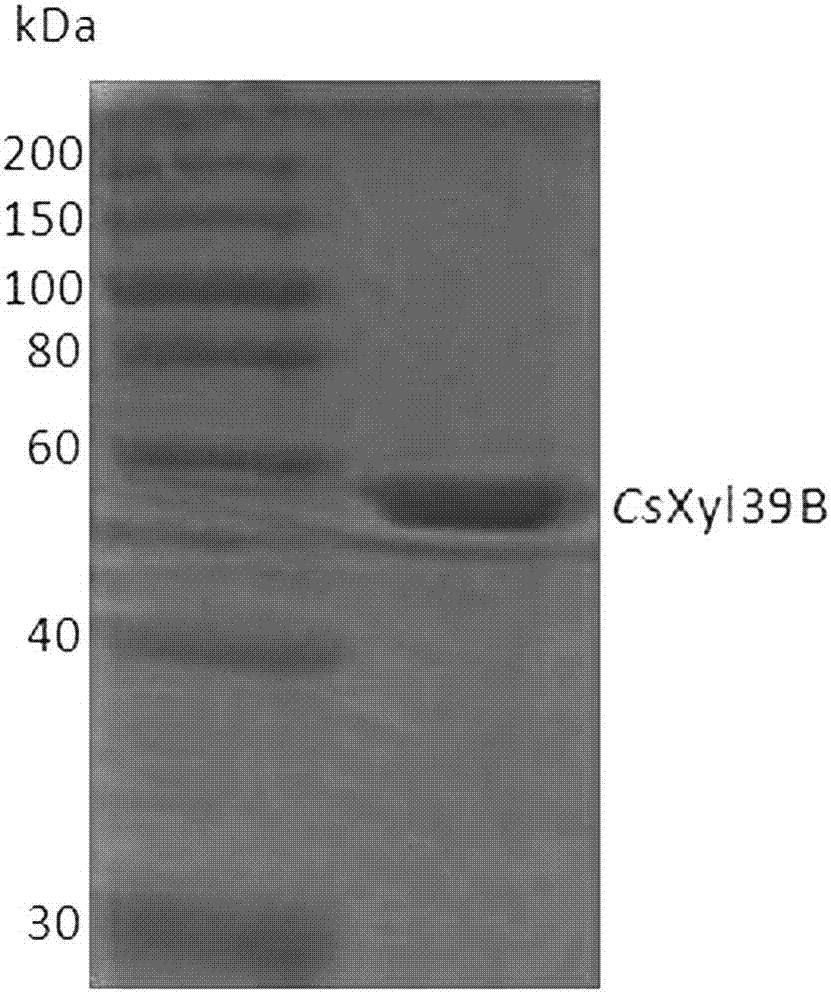Beta-xylosidase and application thereof
A technology of xylosidase and xylosyl, which is applied in the application field of biotransformation and can solve the problems of large effect and poor tolerance.
- Summary
- Abstract
- Description
- Claims
- Application Information
AI Technical Summary
Problems solved by technology
Method used
Image
Examples
Embodiment 1
[0060] Example 1. Obtainment of β-xylosidase CsXyl39A and CsXyl39B and their amino acid sequences
[0061] The genomic DNA of Caldicellulosiruptor saccharolyticus (ATCC 43494 / DSM8903) was extracted and used as a template. PCR amplification was carried out with forward primer 1 and reverse primer 1 (see Table 1) to obtain β-wood The gene sequence of glycosidase CsXyl39A is shown in sequence 3. PCR amplification was performed with forward primer 2 and reverse primer 2 (see Table 1) to obtain the gene sequence of β-xylosidase CsXyl39B, as shown in sequence 4.
[0062] The PCR amplification system and conditions of the two are the same, specifically: 50 μl PCR amplification system includes 1 μl genomic DNA (15 ng / μl), 25 μl 2×EASYPfu SuperMix, 1 μl Primer (10 micromolar) and 22 microliters of sterilized ultrapure water. The PCR reaction conditions were: 95°C pre-denaturation for 5 minutes; 94°C denaturation for 30 seconds, 55°C annealing for 30 seconds, 72°C extension for 3.5 minutes...
Embodiment 2
[0067] Example 2. Determination of β-xylosidase hydrolysis activity:
[0068] The enzyme activity was determined with p-Nitrophenyl-β-D-xylopyranoside (pNP-X) as the substrate. In 100 microliters of sodium citrate buffer (pH 5.0), add 80 microliters of pNP-X (10 mmol / L) and 20 microliters of β-xylosidase CsXyl39A obtained in Example 1 above in different concentrations. Or CsXyl39B, after incubating in a water bath (75°C) for 5 minutes, add 100 μl of 2 mol / L sodium carbonate solution to stop the reaction. The reaction solution was then put into a spectrophotometer, and the absorbance value was measured at 405 nm (see image 3 ). 1 millimole of p-nitrophenol is released from the substrate by hydrolyzing the substrate per minute, which is defined as 1 unit of enzyme activity.
[0069] Measurement result: the result of enzyme hydrolysis activity is as image 3 It is shown that the specific enzyme activity of β-xylosidase CsXyl39A and CsXyl39B to pNP-X is 180 enzyme activity units / mg ...
Embodiment 3
[0070] Example 3. The effect of organic solvents on the hydrolytic activity of β-xylosidase CsXyl39A:
[0071] The hydrolytic activity of β-xylosidase was measured with pNP-X as a substrate. Add organic solvents (organic solvents of methanol, ethanol, isopropanol, n-butanol, acetone or acetonitrile) to make the final concentration of the system into the hydrolysis reaction system. The reaction system is in 100 microliters of sodium citrate buffer (pH 5.0), add 80 microliters of 10 mmol / L pNP-X, then add 20 microliters of CsXyl39A enzyme mixed with the above organic solvent, incubate in a water bath (75°C) for 5 minutes, and then The reaction was terminated by adding 100 microliters of sodium carbonate solution (2 moles / liter). The reaction solution is then put into a spectrophotometer, and the absorbance value is measured at 405 nm (see Figure 4 ). The hydrolysis release of 1 millimole of p-nitrophenol from the substrate per minute is defined as 1 unit of enzyme activity. The...
PUM
 Login to View More
Login to View More Abstract
Description
Claims
Application Information
 Login to View More
Login to View More - R&D
- Intellectual Property
- Life Sciences
- Materials
- Tech Scout
- Unparalleled Data Quality
- Higher Quality Content
- 60% Fewer Hallucinations
Browse by: Latest US Patents, China's latest patents, Technical Efficacy Thesaurus, Application Domain, Technology Topic, Popular Technical Reports.
© 2025 PatSnap. All rights reserved.Legal|Privacy policy|Modern Slavery Act Transparency Statement|Sitemap|About US| Contact US: help@patsnap.com



